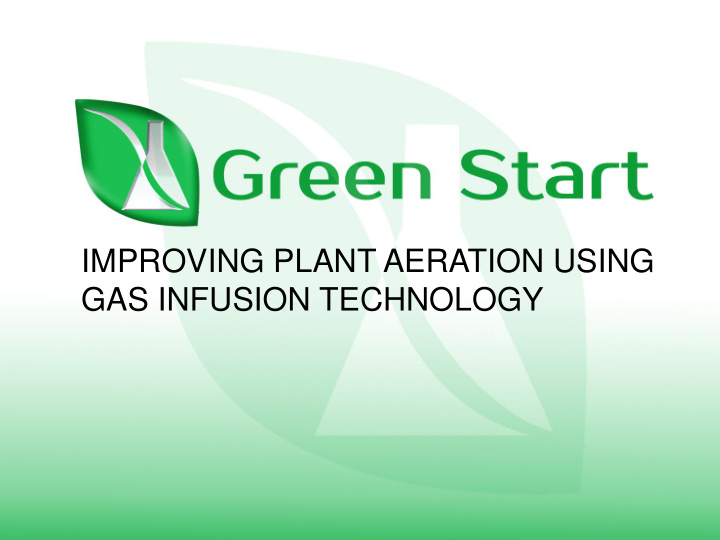



IMPROVING PLANT AERATION USING GAS INFUSION TECHNOLOGY
AERATION IN WASTEWATER • Municipal sewer collection systems-Odor Mgmt. – Lift and transfer stations • Lagoons / Retention Ponds – BOD / COD treatment – Enhanced bio-activity – Sludge reductions • Facilities & Plants – Head works – Aeration augmentation / replacement – Post aeration /disinfection
Common Types of Aeration • Mechanical – Rotors or Brush – Slow & High Speed Splash – Induced Aspiration • Combination – Submerged Turbine with compressor – Jet (pumps with compressor) • Diffused – Coarse bubble – Fine Pore – Flexible membrane • Gas Infusion Technology – Supersaturation of soluble gases
Aeration • Aeration is the process of placing air into water as part of the treatment process. – Air contains slightly less than 21 % oxygen – Air “bubbles” high buoyancy causes off -gassing – Air bubbles “strip” and carry odors to the surface. – Aeration best suited for deep lagoons or tanks – Aeration systems are designed to run 24/7 – Aeration systems average under 35 % efficiency Oxygen Transfer Ratio
Oxygenation • Oxygenation is the process of entraining dissolved oxygen into water – Utilizes oxygen gas to saturate carrier water – Dissolved oxygen does not form bubbles; eliminates off gassing – DO remains in suspension until sheared or consumed – Effective even in shallow trenches or streams – Designed to run based on DO demand or set point – High efficiency Oxygen Transfer Efficiency (99+%)
Wastewater Energy Usage Energy usage in WWTP
Why Bubble knowledge is Important. • Bubble size can impact effectiveness of mass transfer – Impacting rate of rise – Amount of interface area – Transfer efficiency • Varying fluid conditions impact behavior of bubbles. – Surfactants – Viscosity – Density • Determining bubble size for best “aeration” objective for wastewater influent
Basic Bubble Dynamics • Typical shapes are spherical for smaller and ellipsoidal for larger bubbles • Bubbles oscillate their shape and trajectory as they move through fluids • The movement of a bubble results in a continuous change of the interface with the liquid. • Bubbles reach terminal velocity rapidly based on buoyancy rise and drag force during ascent • Bubbles grow as they rise in fluid column, until they disintegrate into smaller bubbles near surface, and gas off.
Bubble Movement • Bubbles in turbulent flow vary their trajectory, behavior and evolution. – Example: stream of bubbles in a rising plume will accelerate faster than a lone bubble. • Shearing of fluids creates lift perpendicular to velocity shear • Drag factor affected by viscosity and density of liquid, which are affected by temperature
Fluid Flow Around Bubble Clean Water – Faster rising Surfactant Present-Slower Rising
Mechanical Energy Efficiency Average of Mfgs.
Gas Infusion Technology Efficiency Example Electrical costs based on 90% operating time 12
Gas Infusion Technology • Two gasification processes – Fixed bubble size – “Nano” Sub -micron – Variable size – By application requirement • 0.25 and larger for DAF, IAF processes • Mixing requirements • High Density Oxygenation Processes • Alternate Gas Rich Solutions CO2, N, etc. • Delivery methodologies – Green Start Designs – Engineered to meet application requirements
Gas Infusion Technology • Dissolved Gas levels in carrier fluid exceeding 800 PPM • Infusion Technology bubble size - nano – Low buoyancy factor reduces off gassing – Modifiable bubble size for optimum performance – Moderate mixing action range • Low energy to lbs/O2/day operation • Operates utilizing wastewater side-stream or external fluid source.
Gas Infusion Technology • Use wastewater as carrier; side stream of flow. • Infuse carrier with supersaturated dissolved oxygen • Return or direct oxygen rich carrier to basin or tank • Offers O2 as preferred electron receptor to clock formation of H2S • Treat at wet well, manhole or interceptors along collection system
Infusion Technology Advantages • Delivers more dissolved oxygen than any other form of aeration. • Can be injected into shallow stream or partially full pipe. • Dissolved oxygen “emulsion” is stable resulting in minimal losses to natural off gassing. • Utilizes a fraction of the energy required by other technologies. • Competitive capital costs and low operating costs • Compact footprint and minimal installation requirements
Infusion Technology IT-15 IT 50 New Model in Production IT-50 System Green Start LLC LeClaire, IA 17
Recommend
More recommend